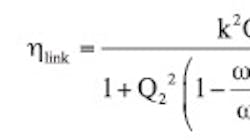Wireless Power Minimizes Interconnection Problems
Find a downloadable version of this story in pdf format at the end of the story.
Use of wireless power involves the magnetic coupling of conductors configured so that the change in current flow through one conductor transfers a voltage in another conductor through electromagnetic induction . The amount of inductive coupling between two conductors is determined by their mutual inductance.
You can enhance wireless power transmission with the application of resonance effects. This technique employs transmitter and receiver inductors tuned to a mutual frequency. This enables power to be transmitted over a distance of up 1/4 or 1/3 times the size of the primary coil. Transmitting and receiving coils are usually single layer solenoids or flat spirals with series capacitors, which, in combination, allow the receiving element to be tuned to the transmitter frequency.
Electromagnetic induction is a function of the frequency and the intensity of the conductorís current and voltage that produces the fields. The higher the frequency, the greater the induction effect. Energy transfers from the conductor that produces the fields (the primary) to any conductor on which the fields impinge (the secondary). You can increase the coupling between two conductors by winding them into coils and placing them close together on a common axis, so the magnetic field of one coil passes through the other coil. Coupling must be tight to achieve high efficiency. If the distance from the primary to the secondary increases some of the magnetic field will miss the secondary, lowering the coupling.
Common uses of resonance-enhanced electrodynamic induction are charging the batteries of laptop computers and cell phones, medical implants and electric vehicles. A localized charging technique selects the appropriate transmitting coil in a multilayer winding array structure. Fig. 1 shows a typical wireless transmitter. Resonance is used in both the wireless charging pad (the transmitter circuit) and the receiver module (embedded in the load) to maximize energy transfer efficiency. This approach has been adopted as part of the Qi (pronounced “chee”) wireless charging standard developed by the Wireless Power Consortium.
LINK EFFICIENCY
The effectiveness of the electrodynamic induction is called link efficiency, ηlink. It is a measure of the primary and secondary coils ability, to transfer energy from one coil to the other:
Where:
k = Magnetic coupling factor
= Unloaded quality factor of the primary circuit
= Unloaded quality factor of the secondary circuit
= QE = Effective Q
Where:
RE = Effective load resistance which models the rectifier including the output filter capacitor and the actual load resistance RL. The relationship between RE and RL is
If series resonance is used on the secondary side
ω = Primary angular velocity (2πf)
ω 2 =Secondary angular velocity (2πf2)
L 1 = Primary inductance in Henries
r 1 = Primary dc resistance in Ohms
L 2 = Secondary inductance in Henries
r 2 =Secondary dc resistance in Ohms
The loaded quality factor is:
For maximum efficiency:
Tune the link to the secondary resonant frequency
Set the effective load resistance to:
To maximize kQ (figure of merit):
Q is called the system quality factor. It should be noted that a low magnetic coupling can be compensated by an increased system quality factor.
Therefore, optimum efficiency =
Fig. 2 plots the optimum link efficiency as a function of the figure of merit for the coils, which is η opt vs. kQ.
One way to manage a high k value is to use a ferromagnetic shield (core) enhances the magnetic coupling factor and reduces the stray magnetic field. Fig. 3 shows the magnetic field resulting from a ferromagnetic shield with and without ferromagnetic shielding.
Another way to manage a high efficiency inductive solution is maximize the Q or Quality factor for the inductive coils. Table 1 lists typical wireless power core from RRC and Fig. 4 are plots of Q vs. Frequency for these cores.
Generally, for any type of coil type the magnetic coupling factor, k, can be improved by reducing the vertical distance between the coils and aligning the coils vertically as shown in Fig. 5a, lateral misalignment (Fig. 5b) and angular misalignment (Fig. 5c) degrade efficiency.
EVALUATION BOARD
To help designers evaluate the feasibility of developing a wireless power transmission system, RRC Power Solutions Inc. has introduced a wireless power evaluation kit to allow OEMs to become familiar with the inductive coupling technology. The kit (Fig. 6) consists of a 5W (5V,1A) Qi compatible wireless power transmitter and receiver in a self-contained testing module. Users can remove the board and coil from the module housing and embed them into a design for hands-on device evaluation. RRC will provide detailed instructions on embedding the kit into a device at www.rrc-ps.com.
Download the story in pdf format here.
